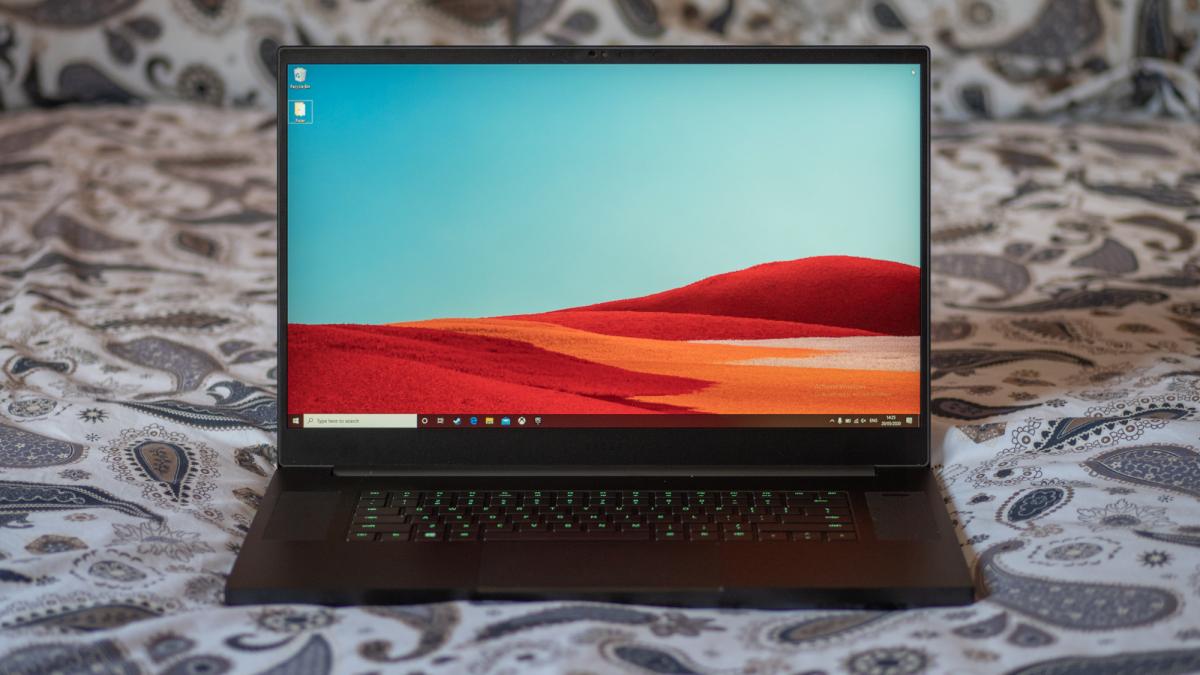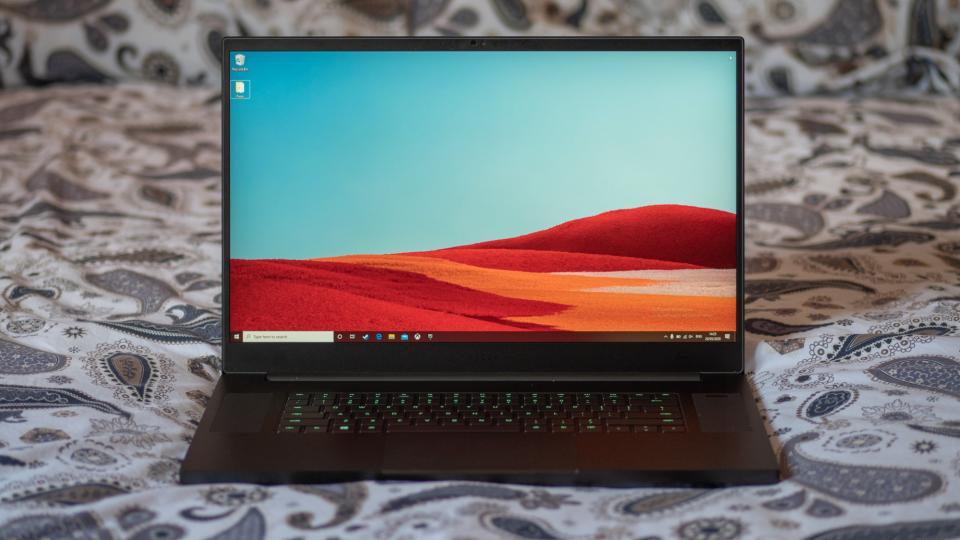
Could Razer’s new 17in powerhouse laptop be the biggest challenger to Apple’s 16in MacBook Pro?
Pros Slim and powerfulFantastic smooth gaming screenSuperb gaming performanceCons Expensive4K screen only available on top model
Razer makes some pretty powerful laptops but the Razer Blade Pro 17 is the biggest and baddest of the lot. With the latest 2020 refresh now upon us, this monster of a laptop is more powerful than ever.
Indeed, with the latest Intel CPUs and Nvidia GeForce RTX Super graphics silicon inside, Razer’s premium machine poses a serious threat to Apple’s finest – the 16in MacBook Pro.
Razer Blade Pro (2020) review: What you need to know
The Razer Blade Pro sits at the top of Razer’s range and is sold as a dual-purpose machine for gaming and heavy duty creative work such as video editing and 3D design.
The 2020 update doesn’t see much change on the design front. The Pro still has a large 17in display and a stylish chassis hewn from a thick chunk of aluminium, all finished in smart, matte black. The layout of the keyboard has been tweaked to include a wider right Shift key and there’s now a full-size SD card slot on the right edge but, otherwise, the major changes are all to the specification of the various components inside.
The display, for instance, available in 1080p and 4K resolutions, comes with higher refresh rates than in the previous model: 300Hz for the 1080p panel and 120Hz for the 4K. And the laptop comes with the latest high-performance Intel Comet Lake CPUs and Nvidia GeForce RTX Super graphics chips.
Razer Blade Pro (2020) review: Price and competition
As you might expect those sorts of specifications mean high prices. We were sent an early unit to try out, with an Intel Core i7-10750H CPU, 1GB of RAM, a top-of-the-line RTX 2080 Super GPU and a 512GB SSD.
That model precise model won’t be available in the UK; instead, we’ll get three models to choose from:
- £2,600: Intel Core i7-10875H, RTX 2070, 16GB RAM, 512GB SSD
- £3,200: Intel Core i7-10875H, RTX 2080 Super, 16GB RAM, 512GB SSD
- £3,700: Intel Core i7-10875H, RTX 2080 Super, 16GB RAM, 1TB SSD
At these sorts of prices, the competition is going to come mainly from the likes of the new Dell XPS 17 (2020), the Asus ROG Zephyrus S17 and the Apple MacBook Pro 16in, all slimline, stylish and powerful laptops with large screens. Of these, we’ve only tested the MacBook so far, and that starts at a slightly lower £2,399 for a machine with a six-core Intel Core i9-9980HK, 16GB of RAM, an AMD Radeon Pro 5300M and a 512GB SSD.
The only 10th-gen Comet Lake-based laptop we have reviewed as of yet, in fact, is the Gigabyte Aorus 15G, which I was very impressed with. It’s only a 15in machine, though and a fair bit chunkier than the Razer Blade Pro. Prices for that machine start at £1,999 for a similar configuration to the base level Blade Pro.

New Apple MacBook Pro (16-inch, 16GB RAM, 512GB Storage, 2.6GHz Intel Core i7) – Silver
£2,169.00 Buy now 

Razer Blade Pro (2020) review: Design and features
If you’ve ever seen a Razer laptop before you’ll know what to expect from the Razer Blade Pro. You can have it in any colour as long as it’s black (with hints of lurid green, of course) and its slab-like chassis is carved from a single block of aluminium that feels solid enough that I wouldn’t want to think about what would happen if I dropped it on my toe.
Decorative adornments are kept to a minimum with only the three-armed Razer logo backlit in green on the lid and the Razer Chroma RGB keyboard glowing with multi-coloured menace on the inside.
Inevitably, given the 17in expanse of screen, the Razer Blade Pro is a fairly heavy machine but it’s reasonably slim and narrow bezels to the left and right of the display keep it as small as it possibly can be. It weighs 2.4kg without the power brick and measures 22mm thick including the rather chunky rubber feet. Two of these feet run the entire width of the underside of the machine and give space for four intake fans to suck air in for cooling, with hot air pumped out of the vents at the rear of the laptop; neatly, these are only exposed when you open the lid.
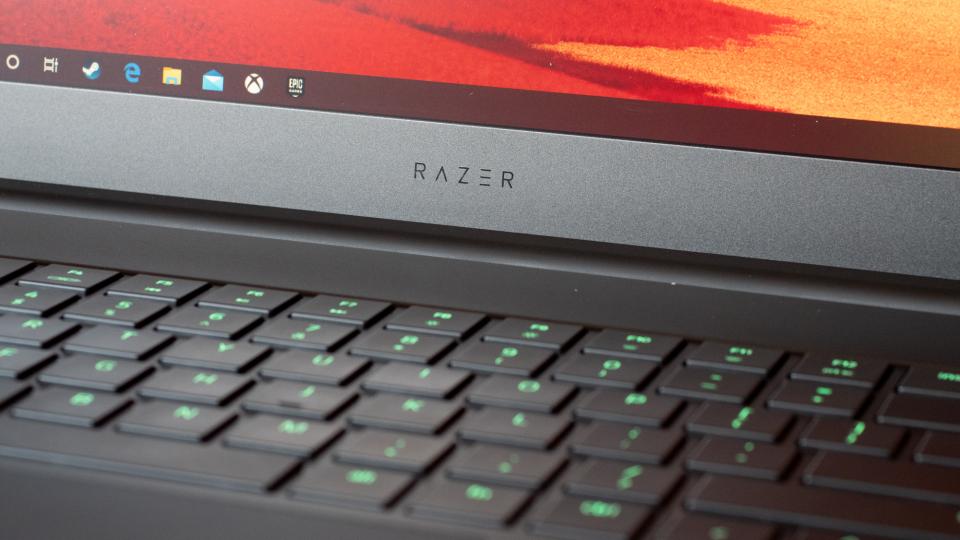
It’s certainly an elegant design and it doesn’t want for physical connectivity, either. On the right edge of the laptop are single USB-A, USB-C, and full-size HDMI ports, plus a full-size SD card slot and, helpfully, these are arranged towards the rear of the machine, giving you space to mouse if you end up using them all.
On the left edge is another USB-C port, a pair of USB-A ports, one 2.5Gbits/sec Ethernet socket and a 3.5mm headphone jack, as well as a proprietary three-pin power input. This being a high-power gaming machine, you can’t run it on USB-C power alone, alas.
Naturally, there’s decent wireless connectivity here, too, with an Intel AX201 module delivering Wi-Fi 6 connectivity, ensuring you get the fastest possible wireless speeds, and Bluetooth 5 as well.
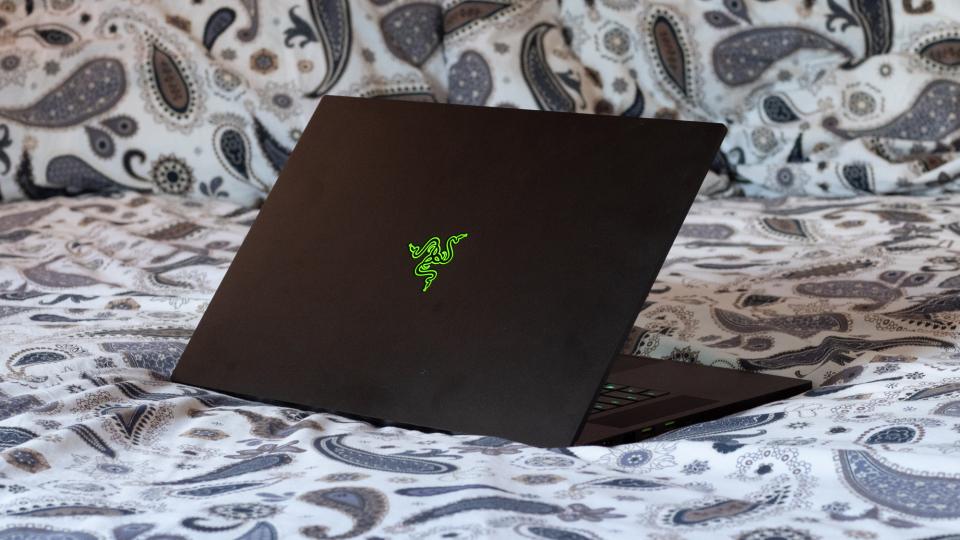
Razer Blade Pro (2020) review: Keyboard, touchpad and audio
Razer, like Apple, seems to have taken a dislike to number pads so the keyboard sits a little isolated in an expanse of black aluminium on the inside. It’s flanked by a pair of speaker grilles, one of which has the laptop’s power button built into it. The speakers go incredibly loud but don’t punch them up too much because they can sound harsh at higher volumes.
The keyboard is nice enough to type on, but the Scrabble tile keys feel a little light in comparison to the Apple MacBook Pro 16in’s lovely damped keys and it’s no match for the fully realised feel of the mechanical switches on the Gigabyte Aorus 15G.
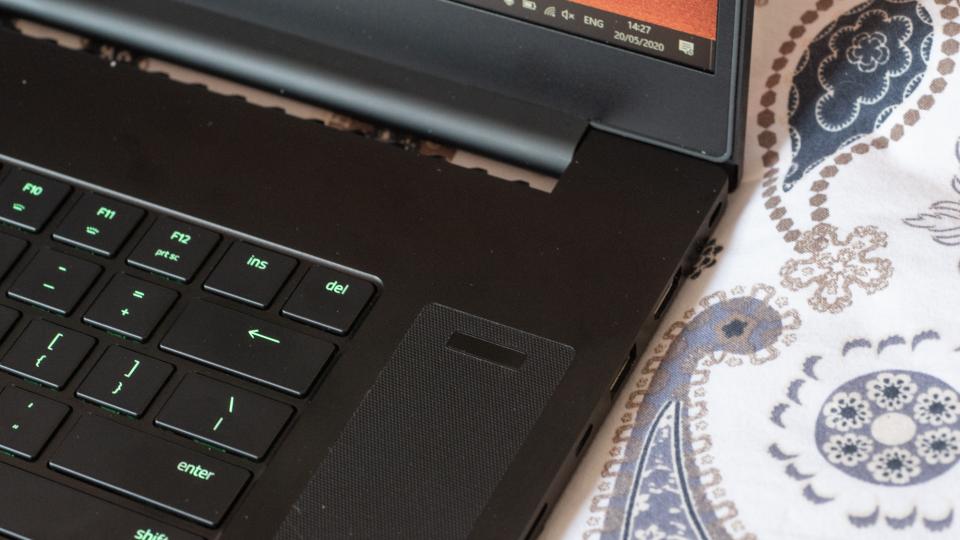
As is the norm with gaming-focused laptops, it’s also equipped with RGB lighting, which is where Razer laptops excel. The lighting is fully customisable via the Razer Synapse app and Razer’s Chroma Studio app, which allows you to select from various lighting animations, specifying the colour and behaviour of each key should you wish. There’s even Philips Hue integration so you can synchronise the colour of your bulbs and keyboard together while gaming.
The touchpad is a little less interesting but it is, nonetheless, effective. It’s nice and big, measuring 135 x 80mm and has so far behaved perfectly well. It’s large enough to perform two-, three- and four-fingered multitouch gestures comfortably and there’s a nice weight to the built-in diving-board style right- and left-click buttons – not too light, not too heavy.
Razer Blade Pro (2020) review: Display
Oddly enough, the Razer Blade Pro (2020) doesn’t come with the OLED screen options that the new 15in Razer Blade comes with. It’s IPS or nothing. However, the refresh rate is just as high – 300Hz on the 1080p model or 120Hz on the 4K.
I love the way a high refresh rate display feels and find it difficult to go back to a normal 60Hz monitor after using something like the display on the Razer Blade Pro; everything just feels so smooth and responsive. It is worth noting, however, that you’re unlikely to find a game so undemanding that you can reach the heights of 300fps even on a 1080p screen like this so it’s a little disappointing that the 120Hz 4K screen option isn’t available on the two more affordable variants.
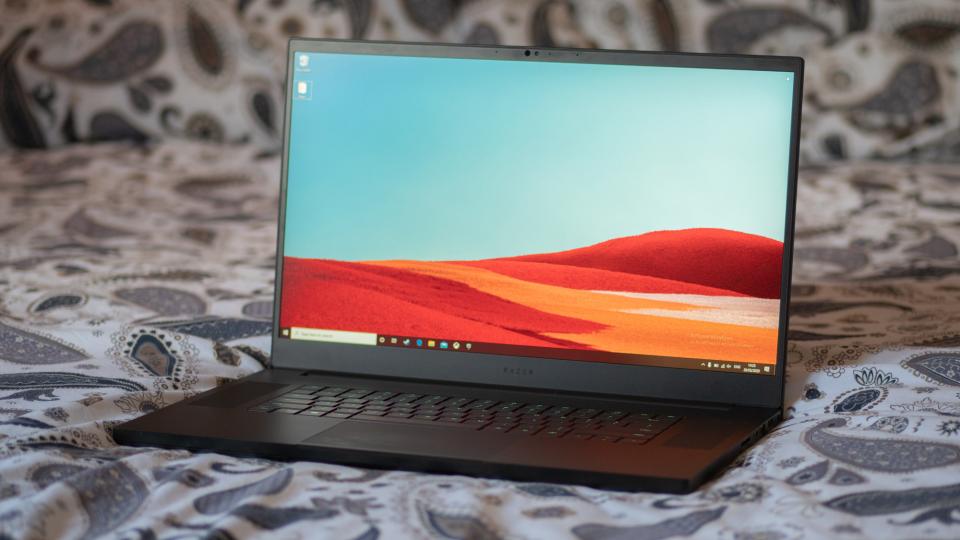
As for image quality, that isn’t quite as good as you can get elsewhere, at least the 1080p 300Hz one on my review model isn’t. The screen isn’t OLED, as I’ve already pointed out, but it’s also not a wide gamut display like the one on the Apple MacBook Pro 16in so it won’t be as nice to edit your Raw photos on.
Technically, it’s solid, rather than exceptional. It produces a colour range that’s 109% of the sRGB colour space and colour accuracy in that colour space is on the money with an average Delta E of 1.78 (the lower the better).
However, peak brightness isn’t the highest we’ve seen at 315cd/m² and, if you’re planning on using the laptop for professional Photoshop work, it’s worth being aware that there’s quite a difference in brightness uniformity from the top to the bottom of the display. I measured a change of more than 120cd/m2 between the brightest and dimmest portions of the screen.
Razer Blade Pro (2020) review: Performance
With the latest 10th gen octa-core Intel Core i7-10875H chip under the hood, it’s safe to say we’re going to see some pretty hot benchmark numbers from all variants of the Razer Blade Pro (2020), especially when coupled with Nvidia’s RTX 2070 or the top-of-the-range RTX 2080 Super GPU as with our review unit.
Alas, the unit I have in front of me doesn’t have the above CPU installed; it is instead running on the lower-powered six-core Core i7-10750H so our 4K media benchmarks don’t show it in its best light. The retail laptops will be significantly faster, if the results from the Gigabyte Aorus 15G are anything to go by:
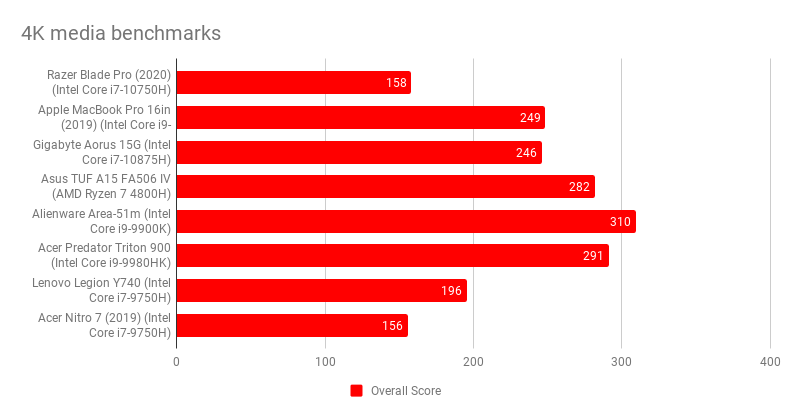
When it comes to other areas of performance, though, the numbers look pretty good. The 512GB SSD is as quick as you need and mostly up with its main rivals:
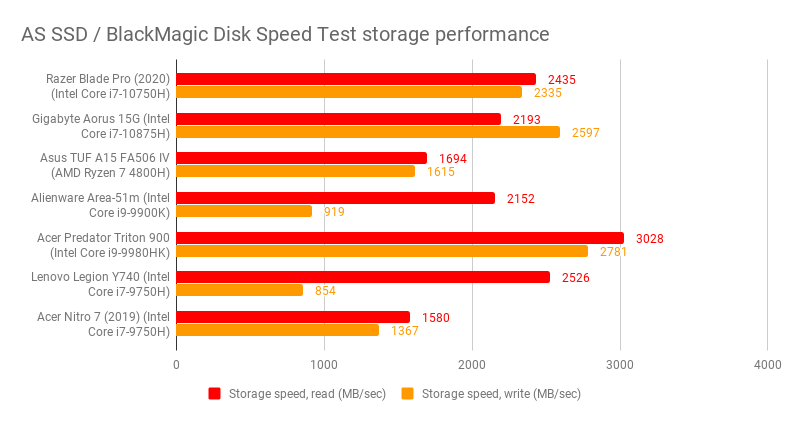
It’s in gaming, however, that the Razer Blade Pro 17 really shines, however. I’ve been playing a few demanding titles on this beast, from Doom Eternal and Control to Hitman 2 and I’ve not seen significant performance issues with any of them, even with maximum quality settings and ray tracing enabled.
You can see how much faster the RTX 2080 Super is than the RTX 2070 Super by comparing the Gigabyte Aorus 15G we tested with the Razer Blade Pro in the graphs below. In the two most demanding of the three tests, it’s significantly faster than Aorus and bear in mind this is early hardware and, Razer tells me, should get faster with further optimisation:
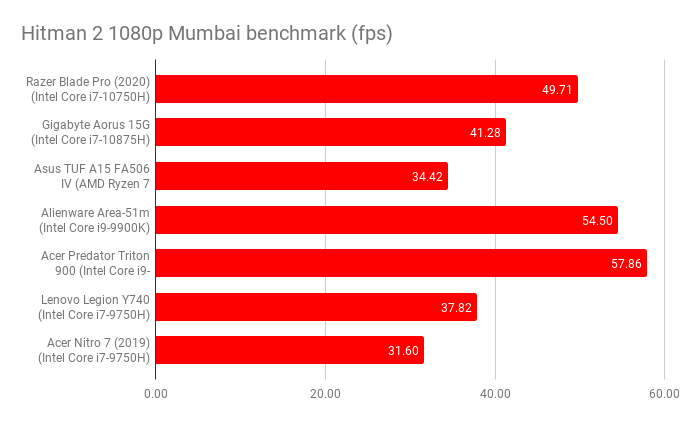
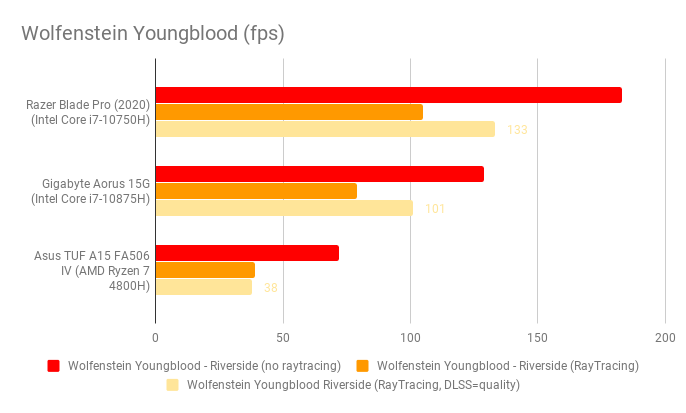
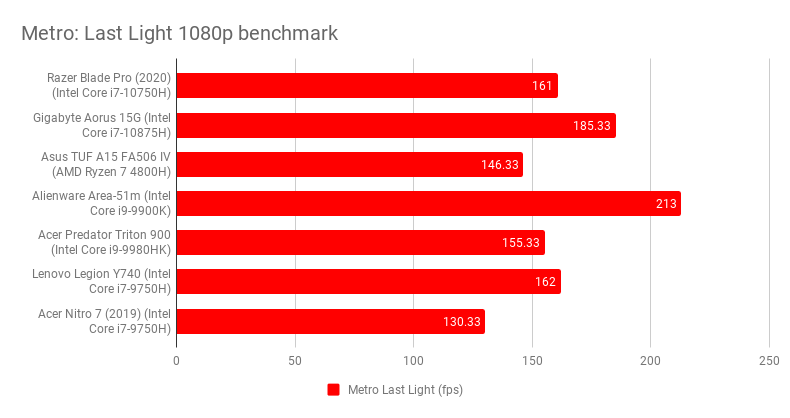
The noise of the fans isn’t too irksome, either. When they’re going full tilt there’s an inevitable continuous rush of air but it isn’t anywhere near as loud as the fans on the Gigabyte Aorus 15G and a lot more bearable as a result.
Razer says it has improved the cooling system on the Pro, with improved fans and a better liquid cooling system so perhaps this lies at the root of its quietness.
Razer Blade Pro (2020) review: Early verdict
There is no doubt that the Razer Blade Pro is a great-looking gaming machine and it’s also surprisingly slim and light for one so powerful. In short, if you want to play the latest PC games but don’t have room for a proper PC and monitor – or you travel a lot and want to take your gaming machine with you – this is going to be the best option available to you right now.
On the other hand, it is very expensive and if it’s simply a powerful, portable machine with a larger screen that you want and the job is photo editing, 3D design or video editing, then the Apple MacBook Pro 16in, which is lighter and slimmer and has a wider gamut display, makes more sense.
